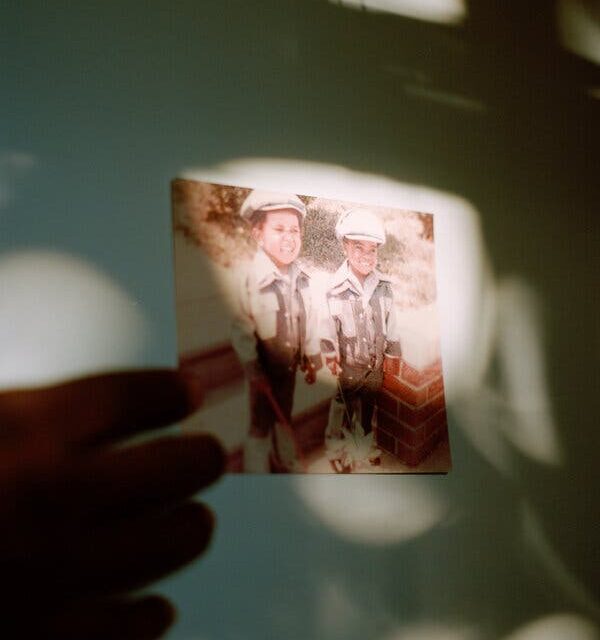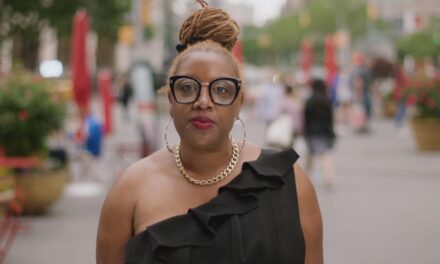Donnell Drinks woke up one morning to banging on his door in the projects of North Philadelphia. It was the late 1980s, and Mr. Drinks, who was 15 and the oldest of three boys, had nodded off after taking his youngest brother to school. He should have been at school himself, but he had stopped going earlier that year. It wasn’t a truant officer at his door, though — no one had ever come knocking about that. Instead, sheriff’s deputies were waiting outside. They were there to evict his family.
The officers told him to get out, not bothering to ask if there was an adult around, which there wasn’t. Mr. Drinks’s dad had abandoned the family a decade earlier, and his mom was in the throes of crack cocaine addiction. For years, Mr. Drinks had been raising his younger brothers, and he had just become a father himself. He’d dropped out of school to support his family by selling drugs, a transition that felt so natural he hardly remembered how it happened.
Groggy and panicked, Mr. Drinks scanned the apartment for essentials, stuffed a shopping cart with clothes for his brothers and wheeled the cart up the road to his grandmother’s overcrowded rowhouse. The officers never asked where he was going.
“There was not one adult that said, Hold a minute. We need to call somebody,” Mr. Drinks said. “Not one adult said, That’s a child.”
At the time, Black teenage boys like Mr. Drinks were being treated less as children in need of help and more as if they were threats to society itself. Crime was rising nationwide, particularly in Philadelphia, where, in 1990, the city recorded 500 murders in a year for the first time. It was a terrifying period, especially for people living in poorer neighborhoods where the violence was worst. But the rhetoric, perpetuated by public officials and overheated headlines, suggested that a new morally depraved generation of teenagers — particularly Black teenagers — were to blame. This idea gave rise to the “superpredator” era and a raft of laws cracking down on juveniles that followed.
Mr. Drinks, now 50 years old, is a small man with a stocky frame and a warm, gaptoothed smile. He keeps his salt-and-pepper beard meticulously fluffed. An animated storyteller who is quick with a metaphor and a motivational quote, he becomes guarded when describing his upbringing — not just because it’s painful, but because he doesn’t want anyone to think he’s trying to justify what happened next. “This is context,” he said, “not excuses.”

In February 1991, when he was 17, Mr. Drinks and his 22-year-old girlfriend, who was a police officer, tried to rob a man named Darryl Huntley. They staked out Mr. Huntley’s house and forced him and his fiancée inside at gunpoint. That violent act led to others. Mr. Drinks stabbed Mr. Huntley, fatally, and was shot himself. Mr. Drinks was arrested while he was in the hospital recovering from his injuries.
By the time Mr. Drinks was brought to trial for Mr. Huntley’s murder, Philadelphia had a new district attorney: Lynne Abraham, a former judge who went on to hold the office for nearly two decades. Pennsylvania law already made life sentences mandatory for first- and second-degree murder convictions, but Ms. Abraham responded to the era’s surge in violent crime by aggressively pursuing the death penalty, an approach that once earned her the moniker the “deadliest D.A.”
She also called for tougher punishments for juveniles. In 1994, she pushed for legislative changes to give prosecutors more power to charge juveniles as adults. “You don’t get any bonus for being under a certain age,” she told The Philadelphia Inquirer at the time. The next year, the state passed a law that required prosecutors to treat children 15 and older as adults when they were charged with certain crimes.
Though Philadelphia had already sentenced many young people to life without parole, under Ms. Abraham’s watch — and with the city’s murder rate remaining high throughout the ‘90s — the number getting that sentence in Philadelphia rose quickly. For some, it may have been a deal worth taking to avoid the death penalty.
Mr. Drinks was tried as an adult and initially sentenced to death. In 1993, his sentence was reduced to life without parole. (His then-girlfriend, who received the same sentence, remains in prison.)
He most likely would have died in prison, but while Mr. Drinks was behind bars, a national effort began to rethink the culpability of young people in the eyes of the law. In the 2005 case Roper v. Simmons, the Supreme Court struck down the death penalty for minors, leaning heavily on new scientific research that showed — “as any parent knows,” Justice Anthony Kennedy wrote — that young people are not like adults. They are more impulsive, reckless and susceptible to persuasion.
The court did not question that minors should pay for committing heinous crimes, but in banning the most severe punishment, it affirmed the possibility “that a minor’s character deficiencies will be reformed.” Real change, Justice Kennedy suggested, was possible.
Mr. Drinks had been in prison for more than a decade when the Roper decision came out. Then one day, a Philadelphia lawyer named Bradley Bridge traveled to the upstate Pennsylvania prison where Mr. Drinks was locked up, and explained to him and the other men who had been given life sentences as boys what the ruling could mean for them.
Striking down the death penalty for minors was only the beginning, Mr. Bridge said. Soon, he predicted, the court would apply the same logic to outlaw mandatory life sentences for juveniles too, potentially giving Mr. Drinks and others serving such sentences a shot at freedom — and giving the city of Philadelphia a chance to rewrite its legacy.
A long list of friends
Mr. Bridge had been delivering his speech inside prisons throughout Pennsylvania for months before Mr. Drinks heard him speak. Mr. Bridge worked for the Defender Association of Philadelphia and had spent nearly three decades representing prisoners who were appealing their sentences. When the Roper ruling came down, he was involved in the case of a teenager facing a mandatory sentence of life without parole. He understood immediately the opportunity that the Supreme Court’s ruling presented not just for his client, but for scores of prisoners.
For Mr. Bridge, it meant pursuing a novel legal theory that might help dismantle what he viewed as a particularly unjust part of the justice system. “Children are children, and they make mistakes,” Mr. Bridge said. “But they grow and change.”
Mr. Bridge began the enormous undertaking of compiling a list of all the prisoners in Pennsylvania who were sentenced to life as minors. No one in the state had ever kept track of this group, who came to be called “juvenile lifers” in the courts and “child lifers” by some of the inmates themselves.
He expected the list to be long. He didn’t expect it to eventually include more than 500 names, nearly one-fifth of the more than 2,800 child lifers in the country. More than 300 of them had come through Philadelphia’s system, making a city with less than 1 percent of the country’s population responsible for more than 10 percent of all children sentenced to life in prison without parole in the United States. No other city compared. Even more glaring: More than 80 percent of Philadelphia’s child lifers were Black. Nationally, that figure was roughly 60 percent.
Racism “undoubtedly occurred in every phase of the criminal justice system,” Mr. Bridge said. “This created an opportunity to try to fix things that had been broken.”
His partner in this work was Marsha Levick, who had co-founded the Juvenile Law Center in 1975 as an idealistic young graduate of Temple University’s law school and gone on to become one of the nation’s foremost experts on juvenile sentencing.
Mr. Bridge and Ms. Levick began traveling the state, arranging meetings with the people on Mr. Bridge’s list and adding names as they went. Mr. Bridge’s first stop was Graterford, a maximum-security facility outside of Philadelphia that, at the time, held more child lifers than any prison in the state. Dozens of men crowded into Graterford’s chapel to hear what Mr. Bridge had to say.
“People wanted to know what was coming down the pike,” remembered Kempis “Ghani” Songster, who was in the room that day. “Is this a ray of light flickering on?”
At age 15, Mr. Songster stabbed another teenager to death in a crack house. Both were runaways working for the same gang. He was given a life sentence for his crime, but it wasn’t until that meeting in 2006, nearly two decades after he went to prison as a scrawny kid who couldn’t grow a beard, that he realized how many other lifers at Graterford had also arrived as teenagers.
“It was like, Whoa, he’s been here since he was a kid, too?” Mr. Songster said. “A lot of us who were child lifers didn’t really know that we were in a distinct class.”
There had never been a reason to talk about age. The courts had treated them as adults, and if anything, being marked as a child in a violent adult prison would only have made them more vulnerable. Now, there was power in the identity.
The child lifers inside Graterford began organizing. They quickly formed a committee called Juvenile Lifers for Justice, which met weekly to discuss the evolving law and science around adolescent development. They drafted pamphlets, circulated newsletters to other prisons and their family members, and kept one another motivated around their common cause.
These conversations also started to change how some of the men thought about why they had committed such serious crimes.
Mr. Songster said he never felt “entitled” to be free. “I can’t wash the blood off my hands that’s on my hands,” he said. But the emerging research, which showed brains aren’t fully developed until people get into their 20s, gave him new understanding. “It made me curious about myself,” Mr. Songster said of the research. “I knew I was a good person, but I couldn’t reconcile the person that I became and I know I am with the person that committed that horrible act.”
The child lifers were also reaching out beyond the prison walls. They invited politicians to visit Graterford and partnered with nonprofit organizations to distribute supplies to local schools.
“We were always trying to break that wall down so people could see we’re humans,” said Don Jones, who was also sentenced as a minor and was the president of Graterford’s N.A.A.C.P. chapter during this period.
Mr. Bridge and Ms. Levick became frequent fixtures at the prison. At each of these visits, Ms. Levick was struck by how the men — imprisoned at such a young age and last in line for any prison edification programs because of their status as lifers — had mastered the nuances of the law and were orchestrating a statewide grass-roots movement from inside prison. “Their desire to come home was real,” Ms. Levick said. “It was palpable, and it made you want to do more.”
Mr. Drinks had spent 10 years at Graterford, but after he was transferred upstate, newsletters coming out of Graterford and messages passed along from old friends became his lifeline. Without a lawyer of his own, he kept his case alive by adapting draft legal petitions circulated by Mr. Bridge. And he documented his accomplishments in prison — articles he’d written, certificates he’d earned, thank-you notes from the nonprofits he’d raised money for — until he had three manila envelopes’ worth of records illustrating all the ways he’d grown.
Still, he never quite let himself believe that Mr. Bridge’s prediction would pan out. He wanted to be prepared, but he was also prepared to be let down.
“It’s like throwing water out of a boat that’s sinking,” Mr. Drinks said. “You’ve got to do it anyway, because if you don’t, the water’s going to get you.”
Throughout this period, lawyers around the country, including Ms. Levick and Mr. Bridge, were bringing new cases, trying to apply the rationale in the Roper ruling to other kinds of sentences for juveniles. At the national level, a key leader in this work was Bryan Stevenson, founder and executive director of the Equal Justice Initiative, a nonprofit.
Mr. Stevenson saw a connection between the superpredator era and the overwhelming number of young Black boys who had been locked away for life.
“You had these criminologists going around saying that some children aren’t children. Some kids look like kids, but they’re really, quote, superpredators,” he said. “That narrative was so prevalent, so persuasive, that you see states all over the country lowering the minimum age for trying children as adults.”
In 2008, the Equal Justice Initiative found 73 children who had been given sentences of life without parole when they were 13 and 14 years old. And all of the people who received those sentences for crimes other than homicide were children of color.
“It just said something about the way in which race was a proxy for a presumption of dangerousness, this presumption of irredeemability,” Mr. Stevenson said.
Then came a series of breakthroughs. In 2010, the Supreme Court abolished sentences of life without parole for minors charged with crimes other than murder. Two years after that, Mr. Stevenson appeared before the court on behalf of two young men who were sentenced to life without parole when they were 14. In its decision in Miller v. Alabama, the Supreme Court struck down all mandatory sentences of life without parole for juveniles. Four years later, in a case called Montgomery v. Louisiana, for which Ms. Levick served as co-counsel, the court made that decision retroactive, fulfilling the prediction Mr. Bridge made in the Graterford chapel a decade before, and giving more than 2,800 child lifers across the country the right to have their sentences revisited.
Mr. Drinks remembers the first time he got a look at Mr. Bridge’s list. It was filled with the names of people he’d known for years, but had never known were child lifers. There was Abd’Allah Lateef, the soft-spoken guy he’d always admired at Graterford, even when he griped about Mr. Drinks’s loud music. There was Luis “Suave” Gonzalez, a big talker whom Mr. Drinks had encouraged to lead one of Graterford’s Latin American cultural exchange groups. And there was Don Jones, a friend so close, Mr. Drinks said, “my brothers call him brother.”
“That was my tear-shed moment,” Mr. Drinks said. “I knew I was on the list, but going down the list and seeing genuine friends?” Now, they might all have a shot at freedom — a shot, but not a guarantee.
‘The election changed everything’
The Supreme Court’s rulings in Miller and Montgomery marked an important rethinking of culpability when it comes to children who commit the most serious crimes. But the practical implications of the rulings were limited: the court hadn’t abolished all life without parole sentences for children — only ones where state laws made the sentences mandatory. And while child lifers now had a chance to make a case for their release, prosecutors could still seek new life sentences. In other states with high numbers of child lifers, including Michigan and Louisiana, as well as some parts of Pennsylvania, that’s just what they did.
In Philadelphia, however, all of the list-gathering and planning that had been taking place for more than a decade began to pay off. Most of the state’s child lifers had been prosecuted in the city, and it was up to its district attorney’s office and court system to move hundreds of people through the resentencing process. “Philadelphia was bad, and everybody recognized it was bad,” Mr. Bridge said.
Ms. Levick added, “In a way, the whole world was watching.”
Philadelphia soon began resentencing and releasing child lifers, starting with those who’d been in prison the longest. But while R. Seth Williams, Philadelphia’s district attorney, initially committed not to resentence anyone to life without parole, he stuck to strict new state sentencing guidelines, which meant that Mr. Drinks and others who had been swept up in the ’90s, would most likely spend many more years in prison.
Mr. Williams viewed this approach as the only way to honor the Supreme Court’s ruling, the Pennsylvania government’s consensus and the rights of the victims. “People often only look at the factors for the defendant. I understand. But they often forget there was a victim,” Mr. Williams said. “Someone was murdered. We just can’t just sweep that under the rug.”
Then came a twist that no one predicted. In March 2017, a little over a year after the Montgomery decision, Mr. Williams was indicted on charges including bribery and extortion and later sentenced to five years in prison. Almost as surprising was who was elected to be his successor: a sharp-elbowed former public defender and criminal defense attorney named Larry Krasner.
Whatever Ms. Abraham, the former district attorney, had been to the city in the 1990s, Mr. Krasner swore to be the opposite. (Ms. Abraham did not respond to requests for comment.) He had run against the death penalty and mass incarceration, and vowed to decriminalize marijuana and end cash bail. One of his first moves after taking office in January 2018 was to fire 31 prosecutors in a purge that became known as the Snow Day Massacre.
When it came to juvenile lifers, Mr. Krasner was more open than his predecessor to considering how people had changed in the decades since committing their crimes. Chesley Lightsey is a former assistant district attorney who worked on Mr. Drinks’s case and others under both administrations. “It took time for me to wrap my head around it: ‘Okay, now we can have much more of a conversation about this,’” she said about the change when Krasner was elected. “It was just a different perspective.”
Under Mr. Krasner, prosecutors paid special attention to reports drafted by mitigation specialists. Those specialists, who are essentially professional storytellers for defendants, interviewed juvenile lifers, their families and anyone else who could offer context. They asked questions about how the inmates had been raised, the trauma and pain that had influenced their actions, what they had done with their time in prison and what they planned to do upon release.
By the time Mr. Krasner took office in January 2018, Mr. Drinks had spent hours spilling his soul to a lawyer and mitigator named Rachel Miller. Over the course of countless calls and several in-person visits, Ms. Miller wove the story of Mr. Drinks’s life into a memo, complete with a two-inch stack of documents highlighting his accomplishments.
The memo covers the most painful moments of Mr. Drinks’s childhood: being abandoned by his father, his mother’s struggle with addiction, getting evicted. It describes how Mr. Drinks would skip school to collect the family’s food stamps before his mother could pawn them for drugs and how, when his mother turned violent, he would take the brunt of her beatings in an attempt to spare his brothers.
But the memo also tells the story of a grown man who spent his time behind bars trying to atone for the crime that put him there. Among the stack of documents is a community college transcript filled with A’s and B’s, an agenda for a workshop he organized with victims’ rights advocates and a photo of him beaming behind a giant check made out to Big Brothers Big Sisters of America. Perhaps most meaningful to Mr. Drinks were the letters he received from other incarcerated men who were members of a youth group he founded attesting to all the ways the group, and Mr. Drinks, had saved them. “I did not know the child that committed the crime he is in here for,” read one of the letters, “but the man I do know is not that same person.”
Before Mr. Krasner’s election, Mr. Drinks was offered a deal of 35 years to life, which would have made him eligible for parole in 2026. Shortly after Mr. Krasner took over in 2018, Mr. Drinks got a new offer: time served.
“The election changed everything,” Mr. Drinks said, referring to Mr. Krasner’s victory.
Mr. Drinks’s case was not unique. Researchers at Montclair State University have found that, under Mr. Krasner, prosecutors began offering child lifers new sentences that were, on average, 11 years shorter than the ones offered to those same people under Mr. Williams. Crucially, the researchers found that child lifers’ release had a negligible effect on public safety. Seven years after they started coming home, the rearrest rate for Philadelphia’s child lifers hovers around 5 percent. That’s small compared with the national rate, where 40 percent of people with past murder convictions are rearrested within the first five years, according to the most recent data from the Bureau of Justice Statistics. As of early this year, only three of the city’s child lifers who were rearrested have been convicted (for marijuana possession, contempt and robbery in the third degree), according to the Montclair State researchers.
For Mr. Krasner, these numbers reveal as a lie the idea that some people are so incapable of change that they should never be offered a shot at it. “It was always wrong to believe that people are either saints or they’re sinners,” Mr. Krasner said.
At his resentencing hearing in April 2018, Mr. Drinks read aloud from a letter before a gallery filled with friends and family, as well as the loved ones of Mr. Huntley, his victim. He apologized to Mr. Huntley’s family and said he knew he had no right to ask anyone in the room for forgiveness, and so he didn’t. But he did promise to spend the rest of his life making amends.
Mr. Huntley’s family members also made statements to the court. In a handwritten letter, Mr. Huntley’s sister described her brother as a loving and giving person. She explained how his murder had crushed her family, derailed her own education and deprived her children of ever knowing their uncle. “My mother still is deeply hurt and our family find it difficult to celebrate Valentine’s Day,” she wrote, “because these horrible, horrible actions took place that evening leading into his death.” She told the court that she did not want to see Mr. Drinks released.
Mr. Huntley’s sister did not respond to an interview request, but Suzanne Estrella, who runs the Office of Victim Advocate in Pennsylvania, said that many victims’ families “flat-out just do not” agree with the resentencings. But she said there were also many families that understood and accepted them. “You have survivors who have lost loved ones and survivors who have loved ones who are incarcerated,” Ms. Estrella said. “So you see all those perspectives coming to the table at the same time.”
As painful as it was, Mr. Drinks said he appreciated Mr. Huntley’s family’s honesty. “I felt it, and I understood it,” he said. “I’m always conscious of the emotion, the hurt, the disappointment, the disdain, all those negative emotions that my actions led to. I’ve got to live the rest of my life counteracting that.”
Three months after the hearing, having won the approval of the parole board, Mr. Drinks met his brothers as he walked out of prison for the first time in nearly three decades. Mr. Drinks remembers his sense of disbelief and being a little carsick as they drove the four hours back to Philadelphia, where he would move in with his brother Damon. The whole way home, he couldn’t shake the feeling that someone was following close behind. “I didn’t want to look back,” he said, “so I kept looking ahead.”
A return to the 1990s?
Of the more than 300 child lifers who became eligible for resentencing in Philadelphia in 2016, all but about a dozen have been resentenced, and more than 220 have been released, the majority of them on lifetime parole. That’s nearly a quarter of the roughly 1,000 total child lifers who have been released across the country. These numbers make Philadelphia, once an outlier in imprisoning minors for life, now an outlier in letting them go. By 2020, the city had resentenced more child lifers than Michigan and Louisiana combined.
What set the city apart, said Mr. Stevenson, of the Equal Justice Initiative, was not just the buy-in from local officials and public defenders, but also the community of child lifers who became their own best argument for release.
“It was the way they organized, the way they cared for one another, the way they modeled a kind of readiness to contribute to society,” Mr. Stevenson said. “These young people had been told they were going to die in prison. Some of them just never accepted that.”
Since the Supreme Court decisions, more than half of all states have outlawed life without parole sentences for children altogether, reducing the number of child lifers left in the country to fewer than 600, according to the Campaign for the Fair Sentencing of Youth, a national nonprofit. Mr. Stevenson’s organization is now working to raise the minimum age at which children can be tried as adults in 11 states, including Pennsylvania, where there is no age floor. Other states are considering abolishing mandatory life without parole sentences for people under 21.
While life without the possibility of parole sentences for juveniles are now rare, they are not unheard of. The now solidly conservative Supreme Court has issued a ruling that could lower the bar for judges to apply the sentence to children in states where it is still allowed. A prosecutor in Oakland County, Mich., is seeking life without parole for a mass shooter who was 15 when he killed four students at his high school in 2021. A judge will have to weigh the horror of his crime against the possibility that, over time, he could change.
The United States is still the only country in the world that gives courts the discretion to send children to prison without the chance of proving themselves later in life at a parole hearing. And the tough-on-crime rhetoric of the 1990s is making a comeback, thanks to a spike in violent crime that began at the outset of the pandemic. In Philadelphia alone, the murder rate has surpassed the record set in 1990 two years in a row, with young people emerging as both victims and perpetrators.
Though this uptick in crime is showing signs of decline, it has prompted a nationwide backlash against progressive prosecutors, including Mr. Krasner, whose comparatively lenient approach has become a lightning rod in local politics. Mr. Krasner was recently the subject of an impeachment effort by Pennsylvania Republicans, and even some Democrats raced to condemn his record during the city’s mayoral primary in May.
Those who were released have become some of the loudest voices for building upon the fragile gains they fought for while on the inside. Their fight now is about abolishing life without parole for everyone, getting young people out of adult prisons and addressing the underlying causes of the violence plaguing Philadelphia and other major cities.
“If you would have dealt with a lot of my issues,” Mr. Drinks said, “they probably would not have escalated to crime.”
It’s not that Mr. Drinks and his fellow activists believe juveniles convicted of murder should not be held accountable. “When we talk to legislators, we don’t say: Throw the doors open, and everybody’s coming home,” Mr. Drinks said. “Our conversation is always that everybody deserves an opportunity to show they’re worthy of coming home.”
Today, Mr. Drinks coordinates a network of former child lifers through the Campaign for the Fair Sentencing of Youth. In any given week, he might be found with two cellphones in hand, flying to Alabama to urge progressive prosecutors to stay the course, organizing retreats for formerly incarcerated men and women, or canvassing city streets through an anti-violence nonprofit he co-founded with Mr. Jones, his friend from Graterford.
Mr. Drinks and other child lifers know that they embody for the public what all the research said about a young person’s capacity for change, and they are keenly aware that their example could help secure other people’s freedom. But they are also wary of being used to suggest that the system works, or allowing it to conceal just how difficult their re-entry into the outside world has been.
While several of Philadelphia’s child lifers have gone on to become an Ivy League lecturer or nonprofit executive, many more are working minimum-wage jobs or are unable to find work. Some are in bad health. Four have died. Nearly all of them are on lifetime parole, with the possibility of being sent back to prison forever looming.
Mr. Drinks credits his brothers, Damon and Kareem, for making his homecoming easier. Throughout Mr. Drinks’s incarceration, the three brothers had remained as close as the prison system would allow, keeping up visits even when he was transferred far away. Often, Damon Drinks would bring along Mr. Drinks’s son, who was just 3 when his father was arrested, and is now a grown man with a family of his own. It is thanks to his brothers, Mr. Drinks says, that he was able to maintain a relationship with his son at all.
Damon and Kareem Drinks’s support continued once their big brother was released. They took him shopping, kept him housed and partnered with him to start a local printing company not far from the city courthouse. Mr. Drinks has not had to struggle to survive, but that doesn’t mean he has not struggled. Five years after he left prison, the terms of his parole still prohibit him from leaving the county of Philadelphia without permission. He got married two years ago, but he has yet to get the approval needed to move out of his brother’s home and in with his wife. And he lives with the constant fear that one act of violence by any of the state’s other child lifers could spell the end of his own tenuous freedom.
This fear is part of what keeps Mr. Drinks connected to the men who were once boys with him on the inside. Just as they did in prison, child lifers have come together to create a buffer against an outside world that often feels hostile and unwelcoming. These bonds are as much a product of their shared experiences as they are a defense against their shared vulnerabilities.
“We’re each other’s co-defendants,” Mr. Drinks said. “We see people want to stray, it’s like, No, come on. We’re going to get to this finish line together.”
Is Philadelphia’s approach today better than a generation ago?
This story is part of a series, Progress, Revisited, in which we’re exploring progress toward and away from racial equity and justice for Black Americans. There are many ways of understanding justice. In the past couple years, violence in Philadelphia has returned to levels not seen since the 1990s. In light of the story you’ve just read, we’d like to know whether you think Philadelphia’s approach to juvenile sentencing has become more or less just than it was then.
This article was published in association with ‘Uncovering Inequality,’ an examination of more than a century of scholarship developed by the Ira A. Lipman Center for Journalism and Civil and Human Rights at Columbia University.
The Headway initiative is funded through grants from the Ford Foundation, the William and Flora Hewlett Foundation and the Stavros Niarchos Foundation (SNF), with Rockefeller Philanthropy Advisors serving as a fiscal sponsor. The Woodcock Foundation is a funder of Headway’s public square. Funders have no control over the selection, focus of stories or the editing process and do not review stories before publication. The Times retains full editorial control of the Headway initiative.





